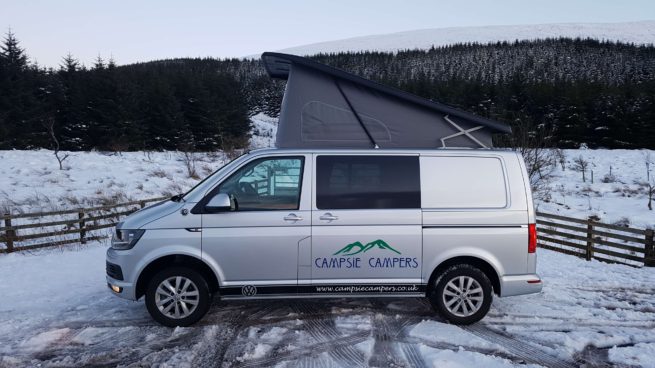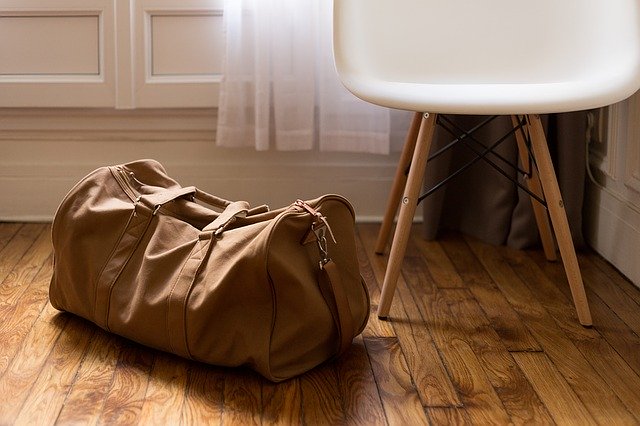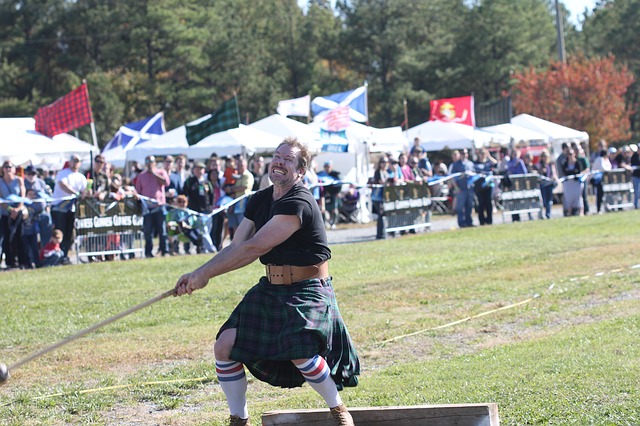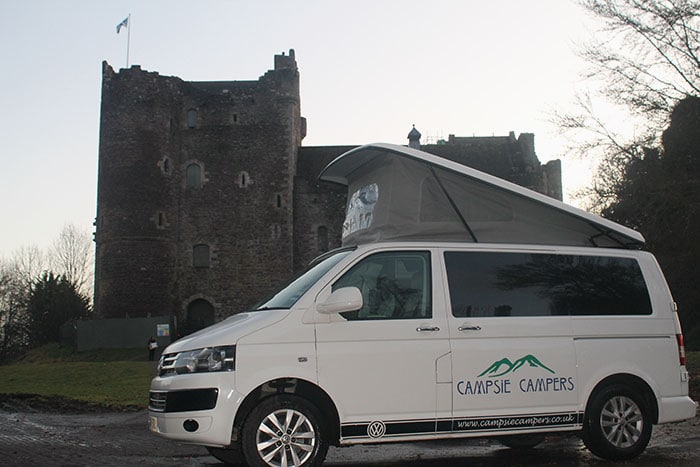- Campervan Hire Scotland
- ++44 (0) 7376 060 672
- info@campsiecampers.co.uk
Winter Campervan Adventures

5 Reasons to visit Scotland in winter
7th November 2018
I just came down from the Isle of Skye…
19th December 2018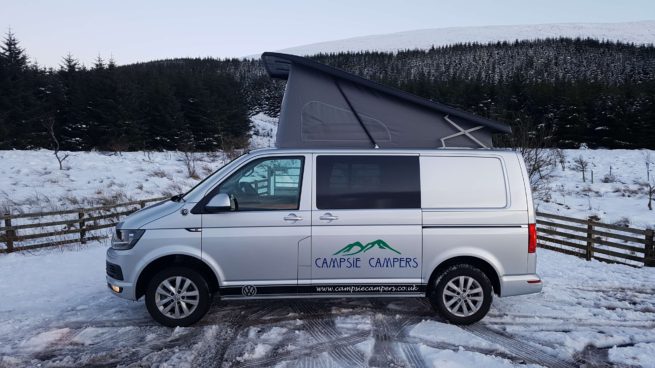
Having blogged about our campervan toasty diesel heating systems, I thought I’d better put them to the test in winter. I set off on my winter campervan adventure into the heart of the highlands in Scotland. The weather was unsurprisingly, looking grim, as is expected for the start of November. The clocks went back the previous weekend and the days were darker earlier – around 4pm.
I set off late (I’m not particularly good at sticking to a schedule) in the direction of the Falls of Bruar. I’ve read about these falls in multiple sites during my research as a romantic spot and a ‘must-see’ attraction. I like to test these theories before passing on information to unsuspecting visitors. My friend had recently been proposed to at the top of the Falls by her soon-to-be groom. Who I can only imagine typed in romantic places in Scotland and was directed by google to the same sites I was.
Big Tree Country

Heading up the A9, I realised my tips to tourists so far had maybe been incorrect. One thing I thought I was sure of was the road rules in Scotland. 70mph for motorways, national speed limit sign indicates 60 mph. Watching motorists speed by as I hovered on the 60mph limit. I can only assume the speed limit, despite national limit signs, was actually 70mph on this stretch of dual carriageway. Either this or my tomtom was lying to me.
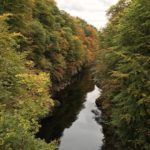
The autumn colours were magnificent approaching Perthshire, known as ‘ Big Tree Country ’ for the various trees that flood the landscape. As I reached the edge of the Highlands at Pitlochry, the dark clouds threatened a downpour and the winter skies loomed with the threat of night. According to my satnav I would reach Bruar at 4:10pm. Enough time, I thought, to take a quick walk and some photos of the Falls before finding somewhere to camp.
How wrong I was! I arrived at the correct time with the rain lashing down and night having already descended. There was a further 20mins walk to the falls so I decided to find a pitch for the night instead. Thankfully our campervans trusty sat-navs have wild camping spots marked. So I could view potential sites near me and pick one in a forest with a loch view to wake up to in the morning.
Loch Tummell
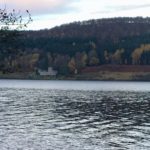
I headed off in the direction of Loch Tummell which was a 30mins drive and looked an ideal spot. The rain was pouring hard as I turned onto the single-track road and the windscreen wipers were going full speed. I could barely see the narrow road but could tell by the darkness through the trees that the loch was very close on my right side. No sooner had I gotten a feel for navigating the tiny road, pulling in safely when a few cars passed me, than I was met by a humungous cherry picker! Of all the things to meet on this unfamiliar, twisty, turney, wee road! 7 miles took an eternity on this dark and gloomy night but I finally found my wild camping pitch. A perfect pitch next to the loch with a footpath to the beach for the morning.
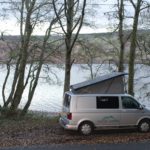
I popped the top on the camper , cooked dinner and had a wee glass of wine to calm the nerves. I could relax now I was in my nest for the night. According to the weather report we were in for a frosty night. I set up the bed, taking the crockery box out beforehand (helps to get a cup of tea in bed). Then vented all the cooking smells and closed the windows for the evening. I turned on the diesel heating system to 20degrees and was stifling within 5 minutes. When I turned it off and the cool down fan kicked in taking most of the warmth with it. Lesson number 1, start the heating system at a mid to high temperature 18- 20 degrees. Then turn it gradually down to 16 degrees or thereabouts before switching it off. You can keep it going all night as it doesn’t use much fuel but I felt warm enough once under my tog duvet.
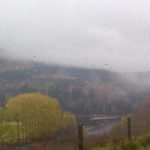
Waking up the next morning, I knew all the previous nights exploits were worth it for this glorious view. The sun came up slowly over the ‘Big Trees’ and the only sound was the burn running gently into the loch and geese in morning flight. I had a peaceful cup of tea. Taking in my surroundings and enjoying being off grid (there is no mobile reception in these remote areas). My plans for the day involved exploring the area then heading to the Cairngorms National Park. Hopefully setting up camp before darkness fell. I packed up and left my pitch early. On the journey back I was met with glorious views of the loch, autumnal colours of beach and pine trees and a mist which settled between the two. A quiet and recommended pitch any time of year.
Falls of Bruar
I parked in the House of Bruar carpark, directed by friendly carpark attendents who smiled regardless of the pouring rain. Conscious that I had not yet showered, I felt a little out of place entering the stylish shopping centre. But the greeters certainly didn’t judge me on my appearance. They directed me to a lavish set of bathrooms that outshone any 5 star establishment. After a quick wash, I helped myself to the free fruit cake and fudge that was on offer. Then set off round the back of the centre towards the Falls of Bruar.
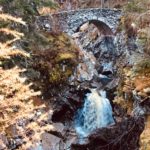
The rain began to ease and the water flowed rapidly down the wide rocky river as I followed the path. The path is a slight gradient walking on the edge of the forest and the river. There are a few stone tunnels on the first part of the walk. These are the remnants of huts and bridges built at the viewpoints by ‘Planter John’ in the 18 th century.
After crossing the lower bridge, the path becomes more strenuous and a steeper climb. It circles round at the upper falls with views all the way down the steep ravine. It then descends again on the carpark side of the river. These are interesting falls but with the peat turning the water a muddy brown colour, I fail to see how this is ‘romantic’. Earthy, yes. But romantic? Yet visitors have been coming here since the 18th century. The famous poet, Robert Burns even wrote a poem on the Falls for the nearby Duke of Atholl in 1787. Steeped in history, this gentle walk with views is recommended.
Blair Castle

The Duke of Atholl was head of Clan Murray who resided in the nearby Blair Castle, erected in 1269. Blair Castle is still a prominent visitor attraction in the village of Blair Atholl. It is host to 30 rooms showcasing weapons, hunting trophies and furniture from the time it was occupied. Tickets cost £13.00 per adult with discount and family tickets available. This gives access to the castle and the gardens. Guides are available to answer questions around the castle and information grids are provided in each room with a description in a variety of languages. The castle closes for winter from the end of October to the end of March.
Blair Castle Caravan Park is situated in the grounds providing 4* facilities from a putting green to a beauty salon. They too are closed over winter but offer electric pitches for campervans from £25 – 30 per night in season. https://blair-castle.co.uk/caravan-estate/caravan-park/booking-prices/ Being on the cusp of the Cairngorms National park and the entrance to the highlands, there are also many walks available for all levels.Cairngorms National Park
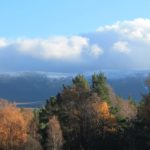
The Cairngorms National Park was my next destination. It is always easiest to head in the direction of
Aviemore
which is a key town in the CNP. However, once there, I always find it a bit overwhelming. It is a bustling tourist town with ample amenities for visitors. Parking is always an issue as it is a central stop-off for those travelling from all four compass points. They have recently developed a Retail Park in the centre of town which provides more parking facilities. However, even in November, I found this an issue. So in an attempt to avoid the crowds I travelled to Glenmore, a smaller town closer to the
Cairngorm mountain
.
It’s not where you stay in this area but that you give yourself enough time to explore its magnitude. You have ample choice depending on season for winter sports, mountain biking, munro-bagging, scenic walks, water sports, and fishing . The beautiful scenery of majestic rivers meeting calm lochs surrounded by mountainous forests lends itself to outdoor activities. There are plenty of options for indoor activities too. A variety of walks and hikes provide opportunities for all abilities to enjoy this natural playground.
Glenmore
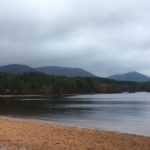
Glenmore itself is small but provides everything you need for your campervan adventure. I stayed at Glenmore campsite which is open all year round. It offers electric hook ups from £16 with your Camping and Caravanning Privilege discount that comes with each camper. Choose from pitches near the facilities with a stunning backdrop of the snow-capped mountains or a woodland retreat with paths leading to the golden sandy beach at the lochs edge.
The Boathouse, visible at the end of the beach, offers a variety of water sports options on Loch Morlich. It also has a café for morning brunch, open from April to October. Walk back towards the main entrance to the campsite to find the Pine Marten Bar . Run by a young and enthusiastic couple, Katie and Scott, the bar provides a variety of local craft beers. There is also a shop on site with all the provisions you need for campervan life. In addition, they are also renovating the Red Squirrel Café, soon to be the Squiralled Away café in March 2019. If that wasn’t enough, they also provide snowsports equipment hire at Snowbadgers Rentals. You literally have everything you need on your doorstep.
Opposite the campsite there is a Youth Hostel restaurant that offers 3-courses from £13. Further along is the Cairngorm Reindeer Herd Centre which offers guided trips to meet the free roaming reindeer. They are closed for the month of January but open the rest of the year. The centre also offer a range of delicacies such as reindeer steak for your campervan cooking menu. About 2 miles up the private road next to the Reindeer centre, leads you to Glenmore Lodge. Glenmore Lodge is Scotland’s National Outdoor training centre, offering courses in all types of outdoor pursuits summer and winter. They also have a bar and restaurant on site which is busy year-round.
Hike & Campervan
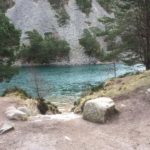
I was a little stuck for time so chose to walk the local Ryvoan route to the Green lochan. Pituresque, stunning views and a gorgeous destination made it worth the 2 hour walk. Despite being listed as a strenuous walk in the Glenmore Forest Park guide, I would class it as moderate. On a sunny winters day it was glorious. A few steep inclines and some tree roots to be wary of but still a moderate walk on a nice day.
With all this available in the tiny town of Glenmore, it’s understandable why people sometimes spend their whole holiday in the Cairngorms National Park. Opening soon to entice campervan adventurers further is the Snowroads route. A 90-mile route which is recommended over winter for a 7-10 day campervan adventure. Or you can carry on to the North West 250, taking in distilleries and historic monuments of Speyside and the surrounds.

